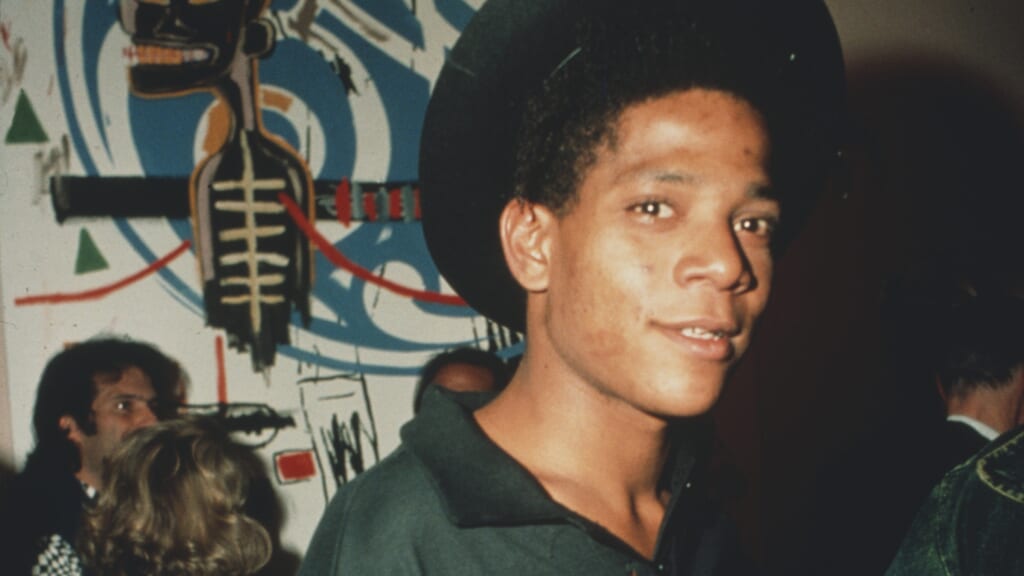Basquiat’s life takes focus in new exhibition curated by his sisters
'Jean-Michel Basquiat: King Pleasure©,' includes many previously unseen works and is the first exhibition to be staged by the late artist's family.
In both pop culture and the art world, the tangible pieces of Jean-Michel Basquiat’s legacy are simultaneously priceless and ubiquitous. While the late artist’s painting “Untitled” broke records at a 2017 auction for garnering the highest sum ever for an American artist’s work, his art and iconography can just as easily be found on apparel at Old Navy, Urban Outfitter and Gap, among others.

Photo: Rose Hartman/Getty Images
As a new gallery exhibition demonstrates, that dichotomy is consistent with Basquiat’s life. Before he was “the radiant child,” he was a Brooklyn-born Black boy of Haitian and Puerto Rican descent raised close to his siblings and father, with a mother who encouraged his early interest in art. Before he was a darling of the art world whose trailblazing life was extinguished at only 27, he was an artist who made New York City his canvas, painting his earliest works on walls, doors and public spaces. “Jean-Michel Basquiat: King Pleasure©,” seeks to tell that other, foundational story through the eyes of those who knew him best.
More from Harper’s Bazaar:
“King Pleasure©” will cover the course of Basquiat’s storied career and short life as well as offer a personal reflection on his legacy through the eyes of his siblings. By offering an unprecedented window into his formative years, the show also aims to upend the long-standing racial stereotypes that have frequently clouded his work and reveal the central role that his Puerto Rican and Haitian heritage and relationship with his Black family played in nurturing his creativity.
Credit: Harper’s Bazaar
“Jeanine and I really are the only two people who can tell this story,” Lisane Basquiat, the elder of Basquiat’s two sisters, told author-activist Salamishah Tillet for Bazaar. Co-curated with youngest sister Jeanine Heriveaux, it’s the first time a retrospective of their brother’s work has been presented by his family. As she further explained: “We wanted to share a little more of the personal side of him with the world. And we’ve had these works in the warehouse for over 30 years, and people haven’t seen them.”
That personal side isn’t solely expressed in the reported 200-plus works the sisters are sharing from their private collection but in full-scale tableaus of the family’s home, reproduced at New York City’s Starrett-Lehigh Building with the help of Ghanaian-British architect Sir David Adjaye.
“There is a sense that somehow his genius couldn’t come from his family, but he grew up in an intellectual family and was really stimulated by the various sophisticated ideas of the time,” noted Adjaye, who also co-designed D.C.’s National Museum of African American History and Culture. “Even though he’s exceptional in that he’s a moment in history at that time, he’s not exceptional in the sense of what Black families were doing for their children and trying to support them at that time,” he later added.
Since Basquiat’s death in 1988, it has again been members of his family who have continued to support and build upon his legacy. Initially helmed by late family patriarch and former accountant Gerard Basquiat, the artist’s sisters have co-administrated the Basquiat estate with their stepmother, Nora Fitzpatrick, since 2013. In the past decade, there has been a marked resurgence in interest in Basquiat’s extensive body of work, the most famous pieces of which the family has licensed to brands including Coach, Target, makeup brand Urban Decay, and many more. For many art purists and several of Basquiat’s contemporaries, this has a point of contention; most recently, as Beyoncé and Jay-Z posed with a little-known Basquiat work for their campaign with Tiffany & Co.
Addressing the argument over whether their brother’s work—which memorably began as street art readily accessible to the public—should be used in commercial formats, Jeanine Heriveaux explained, “from our standpoint, the licensing has really allowed the public to see his works that they might not have otherwise seen because they might not have access to a museum or might not be familiar with them.”
“That is also a way that his legacy continues,” said Lisane Basquiat, who also shared: “In some ways, it’s as much for us as it is for the public. It’s just a way of documenting this incredible character in our family.”
“Jean-Michel Basquiat: King Pleasure©,” opens April 9 at the Starrett-Lehigh Building in New York City.

Maiysha Kai is Lifestyle Editor of theGrio, covering all things Black and beautiful. Her work is informed by two decades’ experience in fashion and entertainment, a love of great books and aesthetics, and the indomitable brilliance of Black culture. She is also a Grammy-nominated singer-songwriter and editor of the YA anthology Body (Words of Change series).
TheGrio is FREE on your TV via Apple TV, Amazon Fire, Roku, and Android TV. Please download theGrio mobile apps today!



